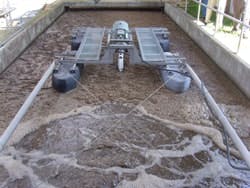When building a wastewater treatment facility 26 years ago, officials in the village of Theresa, Wis., decided on an oxidation ditch design and chose Aire-O 2 aspirator aerators based on their flexibility and energy efficiency. Today, several of those aerators are still in use and the treatment facility operates at even more efficient standards using a new line of the "next generation" Aire-O 2 Triton process aerators.
"We have been working with Aeration Industries and the Aire-O 2 aerators since 1984, when the plant was built," said Guelig. "The aerators provide excellent results with minimal maintenance."
The Oxidation Ditch System
The Theresa wastewater treatment facility is an activated sludge system. The 0.147-million-gal-per-day (mgd) wastewater flow enters the plant through a vertical bar screen/grit chamber and then flows into the oxidation ditch for aeration and mixing. The mixed liquor flows to a final clarifier, and then a UV unit for disinfection and discharge into the Rock River. An overflow lagoon provides storage for excess storm water, snowmelt and capacity for future growth.
High flows during wet weather events can increase flows to 0.187 mgd and "make life interesting and create sludge problems," said Bill Weisensel, plant operator. "But the aerators keep the dissolved oxygen up and treatment has never been an issue."
With increasing demands on the plant, more aerators were added in 1997. Three 15-hp Aire-O 2 aspirator aerators were installed in the ditch, and two of the existing 7.5-hp aerators were moved into the overflow lagoon.
Focus on Energy Efficiency
Aerators are the largest energy consumers at wastewater treatment plants. In an effort to save energy, Theresa officials chose to install two 10-hp Aire-O 2 Triton process aerator/mixers in the oxidation ditch along with one of the existing 15-hp aspirator aerators in June 2010.
The process aerator technology is not an aspirator aerator. Instead, the air is forced down through the shaft of the process aerator/mixer using a regenerative blower. The surface-mounted aerator uses a directional mixer combined with a blower to inject fine bubble-diffused air beneath the water surface. The mixer and blower operate independently from one another, which allows the airflow to be controlled to meet process requirements without any impact on the mixing performance. This dual functionality provides process control and design flexibility and makes the unit suited for processes that require mix-only denitrification cycles such as oxidation ditches or sequencing batch reactors.
Preliminary data show an energy savings of 30% since the process aerator/mixers were installed. Removal rates have been excellent with the Tritons as well. Influent is BOD 225 mg per liter and effluent is 5 mg per liter, or 98% removal. Influent is TSS 225 mg per liter and effluent is 5 mg per liter. Influent NH3 is 30, with effluent NH3 at 0.05, for 99.8% removal.
More intensive electrical saving studies are in progress, but between the removal rates and ease of operation, "it doesn't get any simpler than that," said Guelig.


